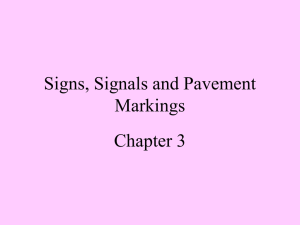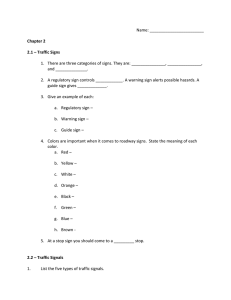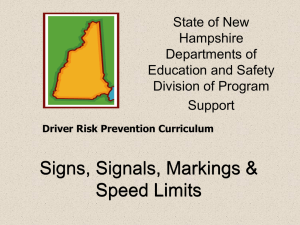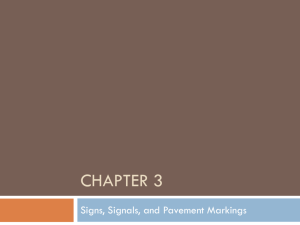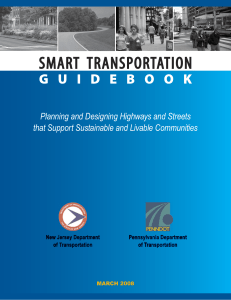File
advertisement
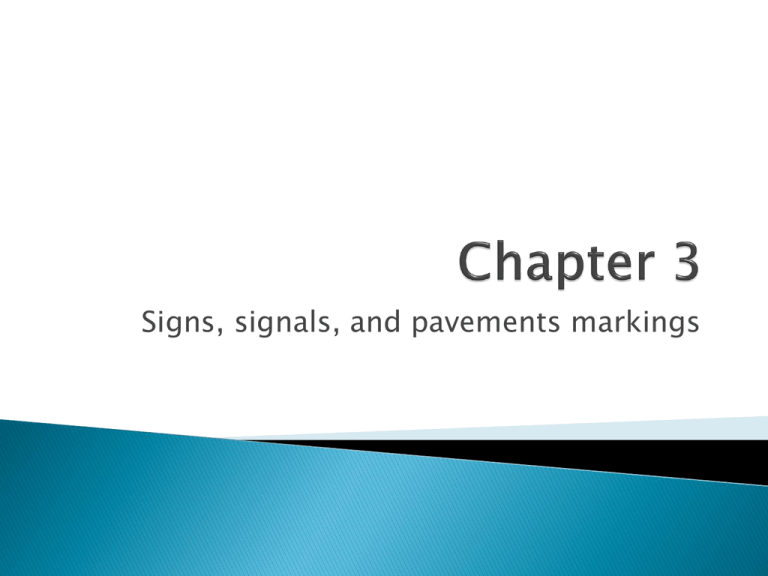
Signs, signals, and pavements markings Key Terms: ◦ Regulatory Stop ◦ Warning Sign Roadway signs provide important information about where you are, where you are going, and what rules to follow. Traffic signs have uniform shapes and color and display words, symbols or a combination of both. There are two types of traffic signs: ◦ Regulatory Signs ◦ Warning Signs (Signs Pre-test) Regulatory Sign: regulates and controls the movement of traffic. ◦ Inform you of laws that apply at a given time or place. ◦ Regulatory signs are: white, black, green on white, or white on black. Most signs are vertical rectangles ◦ Signs show speed limits, turning restrictions, lane use and pedestrian and parking controls. Give commands or set limits. The four most common regulatory signs: ◦ Stop Signs= eight sided, red, and tell you where to stop ◦ Speed Limit Signs = indicated maximum speed you can driver under ideal conditions. ◦ Yield Signs = give way to traffic on the cross road or the road onto which you are merging if close enough to cause a conflict or collision. ◦ Railroad cross buck signs= indicate that railroad tracks are crossing the roadway ◦ (It’s a fact, figure 3.1, 2 Teach) (ROR roadway signs) You must come to a full stop at a stop sign White stop line is painted on the pavement in line with the sign. There may be two white lines indicating a pedestrian crosswalk just beyond the stop line. You are required to stop in front of the first white line you to-if there are no lines, stop in front of or in line with the sign. (Stop-sign Right of Way) pg. 28 As you approach a yield sign, slow down and check oncoming traffic and the traffic behind you. You many need to slow down or stop and wait until the roadway is clear of traffic before you proceed. (may need to judge the speed and distance and determine when its safe) Shows the maximum, or fastest speed allowed on a roadway. Some also show minimum speeds. Alerts you to changes in the condition or use of the roadway ahead. Warning Signs include: Road construction and maintenance, school zones and crossings, railroad crossings, curves, intersections, changes in the width of the road, pedestrian, animal and vehicle crossings. All warning signs are either yellow, fluorescent yellow-green, orange with black letters, they use numbers or symbols and most are diamond shaped. Pg. 26-27 DEM When you see a warning sign, increase your level of alertness to changes in the roadway, in traffic, or in environmental conditions. Pedestrian: you must slow down and proceed with caution. Children playing nearby may dart into the street. (yellow-green sign shaped like a house) Railroad: slow down before you reach the tracks and be prepared to stop. Slow-moving vehicles: Use Caution-appears on the BACK of horse drawn carriage, tractor, self-propelled farm equipment, construction and maintenance machinery. Key Terms: ◦ Guide sign ◦ International Sign Guide Sign: identifies roadways and routes; provides information about mileage to certain destinations; points out roadside services, such as rest stops and service stations; directs you to recreational areas, such as nearby sites of interest. (L1) Identify Which route you are driving on. (fig 3.3) N-S routes begin with an odd number ◦ Ex: I-55 E-W routes begin with an even number. ◦ Ex: I-474 Interstate routes that lead into cities have three digits (195,395). If a three digit route begins with an even digit (295,684) goes around the city and connects to interstate highways at both ends. Figure 3.4, 3.5 Roadside service: Blue signs with lettering Recreational Area: Brown with lettering. Key Terms: ◦ Shared Left-Turn Lane ◦ Reversible Lane ◦ High Occupancy Vehicle Sign Both roadway lines provide directions or warnings for drivers. White lines: Parallel to the roadway separate same-direction traffic into lanes. ◦ Perpendicular to the roadway indicate pedestrian crosswalks and where drivers must stop and intersections and crosswalks. Solid white lines between lanes of traffic moving the same direction are meant to discourage passing at high risk locations but may not prohibit passing. Used to separate traffic traveling in opposite directions and the left edge of multi-lane, divided highways. Yellow lines may be single, double, solid, or broken. A single broken yellow line, or broken yellow lane line (on your side) to the right of a solid yellow line, means that you can pass if it is safe to do so. Double yellow lines divide a roadway, neither you nor drivers in the opposite direction can cross the yellow lines. Parallel solid and broken yellow lines and with white arrows that alternately left and right. Vehicles moving in either direction can use this lane to make left turns off the roadway to an entrance. Using the left-turn lane safely: ◦ Don’t get in the lane too soon. ◦ What for vehicle pulling out of driveways and cross streets. ◦ Use the shared left-turn lane to only turn left. ◦ Figure 3.6 (pg.54) Double dashed (broken) yellow lines are used to make a reversible lane. Improves the flow of traffic in one direction in the morning and the opposite direction in the evening (used in many cities) Other markings include: ◦ Lines, arrows, and lettering designed to guide drivers and pedestrians. ◦ White arrows and words identify stopping points and pedestrian crosswalks. Ex: shared left turn lanes: consist of all three in order to show drivers where they can make left turns. High-occupancy-vehicle (HOV): specifies the minimum number of passengers required (2 or 3 more) to use the restricted lane. ◦ During certain hours of the day some lanes may become restricted. Key Terms: ◦ ◦ ◦ ◦ Traffic Signal Flashing traffic signal Pedestrian signal Lane-use light Keeps traffic moving in an orderly manner. Controlled by a series of traffic signals, arrows, flashing lights, pedestrian signals, or the directions of a traffic officer. Usually located at intersections, where the level of risk increases. More fatalities occur at intersections than at any other locations. –why? Traffic signals are used to control traffic by indicating who has the right-of-way. Special use signals may operate during specific hours or on demand at school zones, fire stations, and some intersections. Traffic signals can be vertical or horizontal and may have one to five separate lenses that give information. (figure 3.7) (Signal sequence) You must either stop of slow down, depending on the color of the light. Flashing red=must come to a complete stop, just like a stop sign. Yellow flashing= slow down and proceed with caution Indicate which lane(S) you can use at any given time. ◦ Used to facilitate traffic flow in tunnels and bridges. ◦ What would you do? (pg.58)
